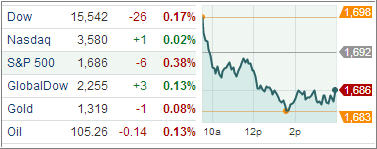Wall Street backed off record highs despite a jump in U.S. new home sales to the highest level in five years and an unexpected expansion for Eurozone manufacturing activity. The Standard & Poor’s 500 Index suffered its first-two day drop in a month, as losses in utility and commodity shares more than offset gains in the tech sector on Apple’s solid earnings. However, the benchmark index has ended twelve of the past fourteen sessions with gains, climbing 4.9% during that span.
Investors received a full slate of mostly better-than-expected earnings at the open. During today’s trading session, stocks declined across the board, with nine of the 10 S&P 500 industry sector indexes moving lower.
The utilities index was the worst performer, shedding 1.6 percent, while the materials and energy indexes fell nearly 1 percent apiece. The tech sector spent the entire session in positive territory after Apple’s earnings topped analyst estimates. The largest tech stock gained 5.1% but chipmakers did not fare as well. Broadcom tumbled 15.1% after its cautious guidance overshadowed the company’s in-line report.
Outside of technology, health care (-0.1%) ended ahead of the broader market. The sector received some support from biotechnology companies. On the downside, heavily-weighted energy, financials, and industrials spent the entire session in a steady decline, which prevented the S&P from staging a meaningful intraday recovery. Elsewhere, the financial sector ended lower by 0.8% as nearly all major banks registered losses.
Today’s new home sales report showed a jump of 8.3% in June to a 497,000 unit annual rate, the highest rate since May 2008. Economists expected a smaller 1.8% gain to a 485,000 unit rate. Sales increased 38.1% from a year ago, the fastest pace since January 1992. On a y/y trend basis, both mean and median home prices continue to increase at double-digit rates, due to tight inventory and improving demand.
Meanwhile, despite a slight pullback last week, mortgage rates were near the highest level since August 2011. Higher rates continued to weigh on refinance applications, which fell 0.7%, reaching the lowest level in two years. Purchase applications also fell, down 2.1%. FHA and VA volume reached its lowest level since January 2008.
Oversea, the Eurozone Manufacturing PMI Index, rose to 50.1 in July, from 48.8 in June, and compared to economists’ 49.1 expectation. This was the first reading above the key level of 50, which denotes expansion, in two years, led by growth out of Germany.
The situation is not the same in Asia. China’s HSBC Flash Manufacturing PMI Index unexpectedly dropped further into contraction territory for July, falling to 47.7 from 48.2 in June, where economists had expected it to remain. A reading below 50 denotes a reduction in output for the sector.
Our Trend Tracking Indexes (TTIs) pulled back as well with the Domestic TTI ending this down day at +3.14%, while the International TTI slipped to +7.04%.
Contact Ulli
